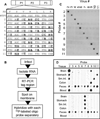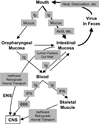Innate host barriers to viral trafficking and population diversity: lessons learned from poliovirus
- PMID: 20951871
- PMCID: PMC3234684
- DOI: 10.1016/B978-0-12-385034-8.00004-1
Innate host barriers to viral trafficking and population diversity: lessons learned from poliovirus
Abstract
Poliovirus is an error-prone enteric virus spread by the fecal-oral route and rarely invades the central nervous system (CNS). However, in the rare instances when poliovirus invades the CNS, the resulting damage to motor neurons is striking and often permanent. In the prevaccine era, it is likely that most individuals within an epidemic community were infected; however, only 0.5% of infected individuals developed paralytic poliomyelitis. Paralytic poliomyelitis terrified the public and initiated a huge research effort, which was rewarded with two outstanding vaccines. During research to develop the vaccines, many questions were asked: Why did certain people develop paralysis? How does the virus move from the gut to the CNS? What limits viral trafficking to the CNS in the vast majority of infected individuals? Despite over 100 years of poliovirus research, many of these questions remain unanswered. The goal of this chapter is to review our knowledge of how poliovirus moves within and between hosts, how host barriers limit viral movement, how viral population dynamics impact viral fitness and virulence, and to offer hypotheses to explain the rare incidence of paralytic poliovirus disease.
Copyright © 2010 Elsevier Inc. All rights reserved.
Figures




Similar articles
-
Multiple host barriers restrict poliovirus trafficking in mice.PLoS Pathog. 2008 Jun 6;4(6):e1000082. doi: 10.1371/journal.ppat.1000082. PLoS Pathog. 2008. PMID: 18535656 Free PMC article.
-
Limited trafficking of a neurotropic virus through inefficient retrograde axonal transport and the type I interferon response.PLoS Pathog. 2010 Mar 5;6(3):e1000791. doi: 10.1371/journal.ppat.1000791. PLoS Pathog. 2010. PMID: 20221252 Free PMC article.
-
The pathogenesis of poliomyelitis: what we don't know.Adv Virus Res. 2008;71:1-50. doi: 10.1016/S0065-3527(08)00001-8. Adv Virus Res. 2008. PMID: 18585526 Review.
-
Random selection: a model for poliovirus infection of the central nervous system.J Gen Virol. 1997 Aug;78 ( Pt 8):1819-28. doi: 10.1099/0022-1317-78-8-1819. J Gen Virol. 1997. PMID: 9266975
-
[Analysis of dissemination pathways for poliovirus].Uirusu. 2009 Jun;59(1):107-14. doi: 10.2222/jsv.59.107. Uirusu. 2009. PMID: 19927995 Review. Japanese.
Cited by
-
Gut Susceptibility to Viral Invasion: Contributing Roles of Diet, Microbiota and Enteric Nervous System to Mucosal Barrier Preservation.Int J Mol Sci. 2021 Apr 29;22(9):4734. doi: 10.3390/ijms22094734. Int J Mol Sci. 2021. PMID: 33946994 Free PMC article. Review.
-
Polio, still lurking in the shadows.J Neurosci. 2013 Jan 16;33(3):855-62. doi: 10.1523/JNEUROSCI.2861-12.2013. J Neurosci. 2013. PMID: 23325224 Free PMC article. No abstract available.
-
Non-Polio Enterovirus C Replicate in Both Airway and Intestine Organotypic Cultures.Viruses. 2023 Aug 27;15(9):1823. doi: 10.3390/v15091823. Viruses. 2023. PMID: 37766230 Free PMC article.
-
A defective viral genome strategy elicits broad protective immunity against respiratory viruses.Cell. 2021 Dec 9;184(25):6037-6051.e14. doi: 10.1016/j.cell.2021.11.023. Epub 2021 Nov 18. Cell. 2021. PMID: 34852237 Free PMC article.
-
Comparison of three neurotropic viruses reveals differences in viral dissemination to the central nervous system.Virology. 2016 Jan;487:1-10. doi: 10.1016/j.virol.2015.09.019. Epub 2015 Oct 16. Virology. 2016. PMID: 26479325 Free PMC article.
References
-
- Anderson GW, Skaar AE. Poliomyelitis occurring after antigen injections. Pediatrics. 1951;7(6):741–759. - PubMed
-
- Arita I, Nakane M, Fenner F. Public healthIs polio eradication realistic? Science. 2006;312(5775):852–854. - PubMed
-
- Arita M, Ohka S, Sasaki Y, Nomoto A. Multiple pathways for establishment of poliovirus infection. Virus Res. 1999;62(2):97–105. - PubMed
Publication types
MeSH terms
Grants and funding
LinkOut - more resources
Full Text Sources
Other Literature Sources
Medical

